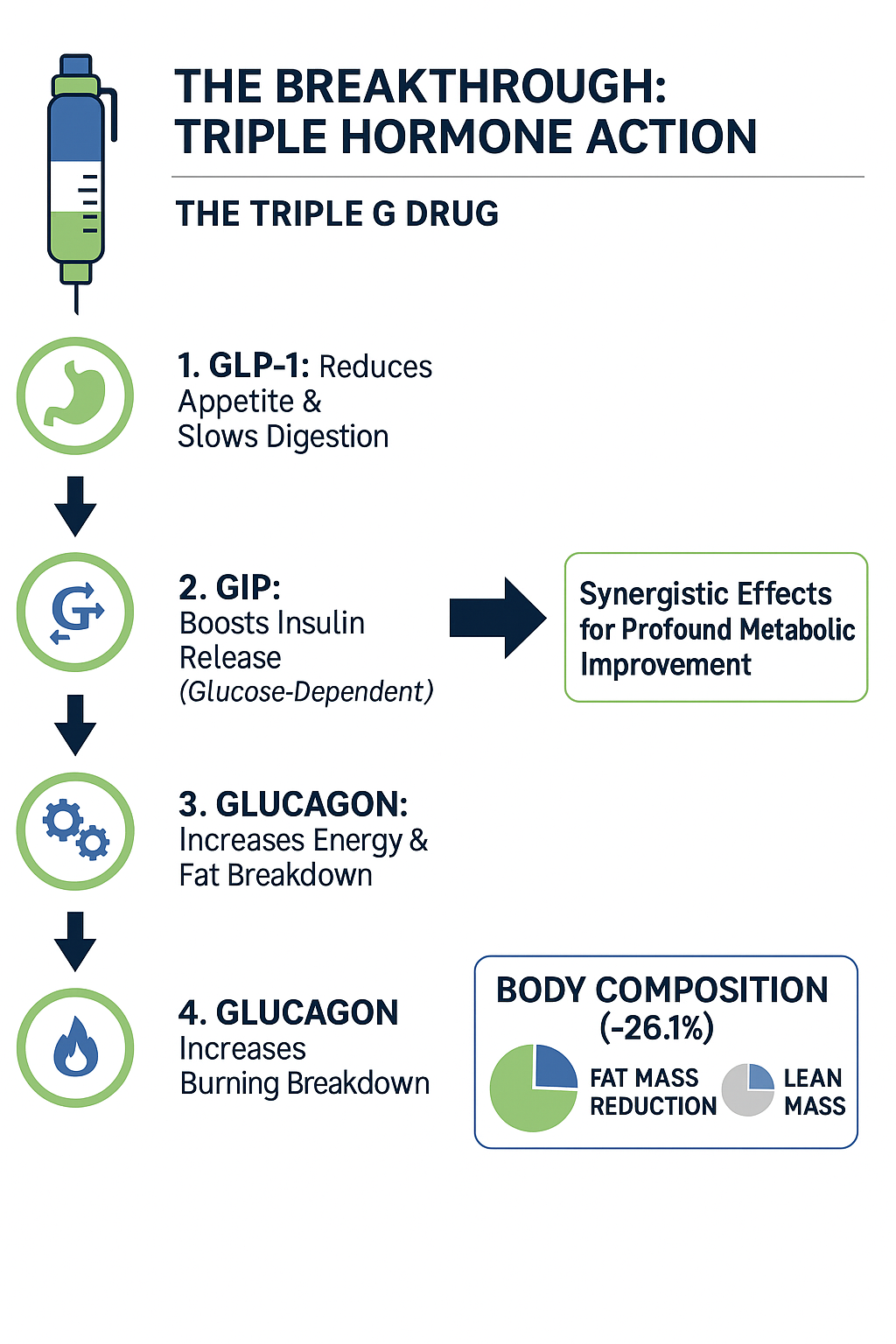
If you're a woman struggling with obesity or weight management, you're not alone. Perhaps you’ve tried countless diets, exercise plans, or even self-help strategies, only to feel frustrated when the results don't last. Obesity is a widespread issue, with more than 1 in 4 women classified as obese. This condition goes beyond physical appearance—it significantly increases the risk of serious health problems, from heart disease to type 2 diabetes, certain cancers, and mental health struggles.
It can feel like a never-ending cycle: you try to lose weight, but health issues related to obesity make it harder to maintain any progress. But what if there was a solution that could help reset the way your body responds to hunger and weight loss? The good news is that recent advances in medicine—specifically Mounjaro (tirzepatide) and Wegovy (semaglutide)—are offering hope to women like you, helping to make weight loss more achievable than ever before.
These medications are not magic pills, but the science behind them is showing real promise. Could they be the support you’ve been waiting for on your weight loss journey?

Understanding GLP-1 Agonists
GLP-1 is a naturally occurring hormone produced in the gut in response to food intake, particularly after meals that contain carbohydrates and fats. A GLP-1 agonist is a type of medication that mimics the action of a naturally occurring hormone. GLP-1 plays a crucial role in managing your body’s metabolic processes, especially those related to hunger, digestion, and blood sugar regulation.
- When you eat, GLP-1 is secreted into the bloodstream and acts on various organs in the body to facilitate digestion and improve nutrient absorption.
- In the brain, GLP-1 helps regulate appetite, signalling feelings of fullness and reducing hunger.
- In the pancreas, it stimulates the release of insulin to manage blood sugar levels.
- It also suppresses glucagon, a hormone that raises blood sugar by prompting the liver to release glucose.
- Together, these actions help control the balance of energy in your body and ensure that blood sugar levels stay within a healthy range.
However, in individuals with obesity or type 2 diabetes, GLP-1 production may not be as efficient, and its effects may be less potent, contributing to difficulties with appetite control and insulin regulation. GLP-1 medications like Mounjaro and Wegovy aim to mimic or enhance the action of GLP-1 in the body, making it easier to manage hunger and blood sugar, thus supporting weight loss.
What Is Mounjaro (Tirzepatide)?
Mounjaro, also known by its generic name tirzepatide, is a once-weekly injectable medication developed by Eli Lilly for the treatment of obesity and type 2 diabetes. It is a dual GLP-1 and GIP (glucose-dependent insulinotropic peptide) receptor agonist, which makes it unique compared to other medications that target only the GLP-1 receptor.
By simultaneously activating GLP-1 and GIP receptors in the body, Mounjaro works on two key metabolic pathways to control appetite, insulin secretion, and fat breakdown.
How Does Mounjaro Work?
Mounjaro works through a dual-action mechanism, targeting both GLP-1 and GIP receptors to help regulate appetite, blood sugar, and fat metabolism:
- GLP-1 Activation: GLP-1 is a hormone produced by the intestines in response to food intake. It reduces hunger, promotes feelings of fullness, slows gastric emptying, and stimulates insulin secretion in the pancreas when blood sugar levels are elevated. This combination of effects helps control both appetite and blood sugar levels.
- GIP Activation: GIP is another hormone released from the gut after meals. It works with GLP-1 to increase insulin secretion in response to food and has a role in fat metabolism. Interestingly, research has shown that when GIP is paired with GLP-1, it can promote greater weight loss and more efficient fat breakdown, particularly visceral fat (fat stored around internal organs), which is a key contributor to metabolic disorders such as type 2 diabetes.
What Are the Benefits of Mounjaro ?
Mounjaro offers a number of benefits, especially for individuals with obesity or type 2 diabetes:
- Significant Weight Loss: Mounjaro has shown superior weight loss effects compared to other medications in clinical trials. A 2022 study demonstrated that patients treated with tirzepatide lost 15-22% of their body weight over a 72-week period, depending on the dose.
- Improved Blood Sugar Control: In patients with type 2 diabetes, tirzepatide has been shown to significantly lower HbA1c levels (a marker of long-term blood sugar control). This is particularly important as high blood sugar levels are a key factor in the development of complications such as heart disease, stroke, and kidney damage. In clinical trials, Mounjaro has also shown to reduce blood sugar levels more effectively than other diabetes treatments.
- Enhanced Fat Loss: Tirzepatide has a particular focus on visceral fat—the harmful fat stored around organs like the liver and intestines. This type of fat is associated with a higher risk of metabolic diseases like diabetes, hypertension, and cardiovascular disease. In clinical trials, Mounjaro resulted in greater visceral fat loss compared to other treatments, which can reduce the risk of these chronic diseases.
- Better Cardiovascular Health: The combination of weight loss, improved insulin sensitivity, and reduction of visceral fat offers potential cardiovascular benefits. As shown in studies like SURPASS-2, Mounjaro has a favourable impact on lipid profiles (cholesterol levels) and blood pressure.
Clinical Studies and Evidence for Mounjaro
The effectiveness of Mounjaro in both weight loss and blood sugar control has been demonstrated in multiple clinical trials. The most notable of these are the SURPASS trials, which tested tirzepatide in individuals with type 2 diabetes and obesity.
SURPASS-1 Trial:
This trial focused on patients with obesity but no diabetes to assess Mounjaro's impact on weight loss. Participants on tirzepatide lost 21% of their body weight on the highest dose (15 mg) over 72 weeks. This was the greatest weight loss observed in this population compared to other treatments.
SURPASS-2 Trial:
This trial objective was to compare tirzepatide with semaglutide (Wegovy), a widely used GLP-1 agonist, in terms of weight loss and blood sugar control. Patients using Mounjaro lost between 15% and 22% of their body weight over 72 weeks, depending on the dose, while those on semaglutide lost around 15-18%. Additionally, Mounjaro improved HbA1c levels and led to greater reductions in weight compared to semaglutide.
SURPASS-3 Trial:
This trial’s objective To evaluate tirzepatide in patients with type 2 diabetes, comparing it with insulin glargine. Mounjaro led to a 12.4% weight loss over 72 weeks, significantly greater than the 2.4% weight loss observed with insulin. Moreover, it was also more effective at reducing blood sugar compared to insulin.
What is Wegovy (Semaglutide)?
Wegovy is a GLP-1 receptor agonist, meaning that it mimics the actions of the naturally occurring hormone GLP-1. Unlike Mounjaro it only has one active ingredient, GLP-1. It was developed by Novo Nordisk and approved by the FDA in 2021 as a treatment for chronic weight management.
Wegovy works by leveraging the natural biology of GLP-1 to help individuals reduce their food intake and manage their weight more effectively. The medication is administered via weekly subcutaneous injection, and studies have shown that it can lead to significant and sustained weight loss when combined with diet and exercise.
How Wegovy Works
Lets have a look at how Wegovy works in our body:
- Appetite Suppression: GLP-1 binds to receptors in the hypothalamus, the region of the brain that regulates hunger. This interaction helps to suppress appetite, making individuals feel full with smaller amounts of food. By enhancing satiety, GLP-1 reduces the drive to eat, which can help prevent overeating or late-night snacking two common challenges for those struggling with obesity.
- Slower Gastric Emptying: GLP-1 slows the process of gastric emptying, meaning food stays in the stomach longer before it moves into the small intestine. This delay contributes to feelings of fullness for a longer period, so people taking Wegovy typically report feeling satisfied after meals for longer, reducing the desire to eat more frequently.
- Increased Satiety: The combination of appetite suppression and slower gastric emptying leads to a significant increase in satiety (the feeling of being satisfied after eating). People who take Wegovy typically feel fuller on smaller portions of food, which can help them stick to a caloric deficit without feeling deprived.
- Improved Insulin Sensitivity and Blood Sugar Control: GLP-1 also enhances the body’s ability to regulate blood sugar. It promotes insulin secretion in a glucose-dependent manner, helping to lower blood sugar after meals. By reducing blood sugar spikes and improving insulin sensitivity, Wegovy can also help people with type 2 diabetes or prediabetes manage their condition more effectively.
Clinical Trials and Efficacy Data
Wegovy has been extensively tested in clinical trials, with impressive results in terms of weight loss and blood sugar control. Several key trials have demonstrated the effectiveness of Wegovy for weight management.
The STEP (Semaglutide Treatment Effect in People with Obesity) clinical trial program is the most comprehensive set of studies for Wegovy. These trials tested semaglutide in a variety of populations, including people with and without type 2 diabetes. The key findings include:
- STEP 1 Trial: In the STEP 1 trial, which included individuals with obesity and without type 2 diabetes, participants who took semaglutide 2.4 mg lost an average of 14.9% of their body weight over 68 weeks. The weight loss was sustained, and many participants continued to lose weight even after a year on the medication.
- STEP 3 Trial: This study tested the combination of Wegovy and a low-calorie diet with increased physical activity. Participants lost an average of 17.4% of their body weight at 68 weeks, showing that combining Wegovy with lifestyle changes produced even greater weight loss.
- STEP 4 Trial: This trial examined the long-term effects of Wegovy over a 20-week maintenance period following initial weight loss. Results showed that, even after a year, participants were able to maintain approximately 75% of their weight loss, demonstrating the sustainability of weight management with Wegovy.
- STEP 5 Trial: In this trial, two year effects of Wegovy were tested in patients with obesity and type 2 diabetes. Participants lost an average of 9.6% of their body weight, and their HbA1c levels (a measure of blood sugar control) improved significantly. This trial showed that Wegovy is also effective in managing both weight and blood glucose in people with diabetes.
Potential Side Effects and Safety Considerations of Mounjaro and Wegovy
As with any medication, there are potential side effects and safety considerations to keep in mind when taking Wegovy or Mounjaro. Although the medication is generally well-tolerated, some people may experience side effects, particularly when they first start the treatment. Both Wegovy and Mounjaro share similar side effects as they both are GLP-1 agonists.
Common Side Effects:
- Gastrointestinal Symptoms: The most commonly reported side effects of GLP-1 medications are nausea, vomiting, diarrhoea, constipation, and stomach discomfort. These side effects are typically mild to moderate and tend to improve over time as the body adjusts to the medication. Taking the medication with food or gradually increasing the dose can help reduce gastrointestinal symptoms.
- Decreased Appetite: While decreased appetite is part of the intended effect of Wegovy and Mounjaro, some individuals may find that they feel too full or have trouble eating enough, especially during the early stages of treatment.
- Headache: Some people report headaches, which is a common side effect of many medications that affect metabolism or appetite.
- Fatigue: A small number of patients report feeling tired or low-energy when starting Wegovy.
Serious Side Effects:
- Thyroid Tumours: GLP-1 receptor agonists carry a black-box warning about the potential risk of medullary thyroid cancer (MTC) and pancreatitis (inflammation of the pancreas). In animal studies, GLP-1 receptor agonists have been shown to increase the risk of thyroid tumours. However, this risk has not been conclusively demonstrated in humans. Still, Wegovy and Mounjaro are contraindicated in people with a personal or family history of medullary thyroid cancer or Multiple Endocrine Neoplasia type 2 (MEN 2).
- Pancreatitis: There is a warning for the potential risk of pancreatitis (inflammation of the pancreas), which is another serious side effect associated with GLP-1 receptor agonists. Symptoms of pancreatitis include severe abdominal pain, nausea, and vomiting. If these occur, patients should stop taking the medication and seek immediate medical attention.
- Hypoglycemia: When Wegovy and Mounjaro is used in combination with other diabetes medications that increase insulin levels (like sulfonylureas or insulin), there may be an increased risk of low blood sugar (hypoglycemia). It's important for patients using Wegovy for diabetes to monitor their blood sugar levels closely.
- Kidney Problems: In rare cases, GLP-1 receptor agonists have been associated with kidney issues, particularly in people who have pre-existing kidney disease. Dehydration caused by nausea or vomiting can also exacerbate kidney problems.
Precautions for Women
- Pregnancy and Breastfeeding: Wegovy and Mounjaro or any GLP-1 medication is not recommended during pregnancy or breastfeeding. It is unclear if the medication passes into breast milk, so it is generally advised to avoid using Wegovy while breastfeeding.
- Dosage Adjustments: Wegovy should be started at a lower dose and gradually increased to minimise gastrointestinal side effects. The usual starting dose is 0.25 mg once a week, with increments of 0.25 mg every four weeks to the target dose of 2.4 mg per week.
Comparing Mounjaro and Wegovy
Similarities Between Mounjaro and Wegovy
- Mechanism of Action:
Both Mounjaro and Wegovy work by mimicking GLP-1, a hormone that regulates appetite, satiety, and blood sugar. By activating GLP-1 receptors in the brain, these medications help to reduce hunger, slow gastric emptying, and improve insulin sensitivity, contributing to weight loss and better blood sugar control. Both are injectable medications, administered once a week via subcutaneous injection. - Indications for Obesity and Type 2 Diabetes:
- Wegovy is approved for chronic weight management in adults with obesity (BMI ≥30) or overweight (BMI ≥27) with at least one weight-related comorbidity like type 2 diabetes, hypertension, or dyslipidemia.
- Mounjaro is currently approved in the UK for the treatment of type 2 diabetes. While it has been associated with weight loss, this is considered a secondary effect. Its use for the treatment of obesity or weight management in individuals without type 2 diabetes is not currently approved in the UK, although such uses are being explored in other jurisdictions.
- Efficacy for Weight Loss:
Both Mounjaro and Wegovy have demonstrated impressive efficacy in clinical trials for weight loss. Mounjaro users typically experience an average weight reduction of around 22.5% to 25% of their starting body weight after approximately 72 weeks, with up to 92% of individuals achieving more than 10% weight loss and 84% surpassing 15% loss. Wegovy, on the other hand, leads to an average weight loss of about 15% to 16% after roughly 68 weeks, with 69% of users losing over 10% of their body weight and 50% exceeding 15%. While both medications promote significant and sustained weight loss, Mounjaro tends to produce a greater magnitude of weight reduction and a higher proportion of patients reaching substantial weight loss milestones. The speed of initial weight loss may be slightly faster with Wegovy, but overall, Mounjaro shows stronger long-term results in most studies.

Conclusion
GLP-1 receptor agonists like Mounjaro and Wegovy have revolutionised weight loss and diabetes care, offering significant benefits in both weight reduction and metabolic health. These medications work by regulating appetite, slowing gastric emptying, and improving insulin sensitivity, leading to notable weight loss and better management of type 2 diabetes. While GLP-1 agonists offer powerful support, lasting weight loss requires a holistic approach. Including focus on nutrient-rich, balanced meals, regular physical activity to boost metabolism and fat loss and address stress, sleep, and mental health for long-term success.
Ready to start your personalised, medically supervised weight loss journey? Join 30000+ women achieving real results with SheMed’s tailored programme-visit shemed.co.uk to check your eligibility and take the first step today
References
- Sharretts, C. W., Galescu, O., Gomatam, S., Davis, K., Shankar, R. R., & Lane, W. (2023). Randomized controlled trial of tirzepatide in patients with obesity and without diabetes. Diabetes, Obesity and Metabolism. https://doi.org/10.1111/dom.14801
- Wilding, J. P. H., Batterham, R. L., Calanna, S., Davies, M., Van Gaal, L. F., Lingvay, I., ... & Kushner, R. F. (2021). Once-weekly semaglutide in adults with overweight or obesity. New England Journal of Medicine, 384(11), 989-1002. https://doi.org/10.1056/NEJMoa2032183
- Marso, S. P., Daniels, G. H., Brown-Frandsen, K., Kristensen, P., Mann, J. F., Nauck, M. A., ... & Buse, J. B. (2016). Liraglutide and cardiovascular outcomes in type 2 diabetes. New England Journal of Medicine, 375(4), 311-322. https://doi.org/10.1056/NEJMoa1603827
- NHS. (n.d.). Obesity - Treatment. Retrieved from https://www.nhs.uk/conditions/obesity/treatment/
- U.S. Food and Drug Administration. (2021, June 4). FDA approves new drug treatment for chronic weight management, first since 2014. Retrieved from https://www.fda.gov/news-events/press-announcements/fda-approves-new-drug-treatment-chronic-weight-management-first-2014
- Medicines and Healthcare products Regulatory Agency. (2023, March 3). GLP-1 receptor agonists: Reminder of the potential side effects and to be aware of the potential for misuse. GOV.UK. Retrieved from https://www.gov.uk/government/publications/glp-1-receptor-agonists-reminder-of-the-potential-side-effects-and-to-be-aware-of-the-potential-for-misuse
Take charge of how you look and feel.
Backed by science. Guided by experts.
SheMed’s medical weight loss programme combines expert care and science-backed treatment to help you feel and look your best — for life.
SheMed’s medical weight loss programme combines expert care and science-backed treatment to help you feel and look your best — for life.
The content on the SheMed blog is provided for general informational and educational purposes only. While SheMed provides professional weight loss services and strives to ensure the information shared is accurate and up to date, we make no representations or guarantees as to its accuracy, completeness, or timeliness. This content should not be taken as personal medical advice or a substitute for consultation with a qualified healthcare provider. Always speak with your doctor or licensed medical professional about your individual health or medical needs before starting any new treatment or programme. Never disregard or delay seeking professional medical advice because of something you have read on this site. SheMed is not responsible for any actions you may take based on the information provided in this blog.
Subscribe to our Newsletter
Thank you! Your submission has been received!
Oops! Something went wrong while submitting the form.




